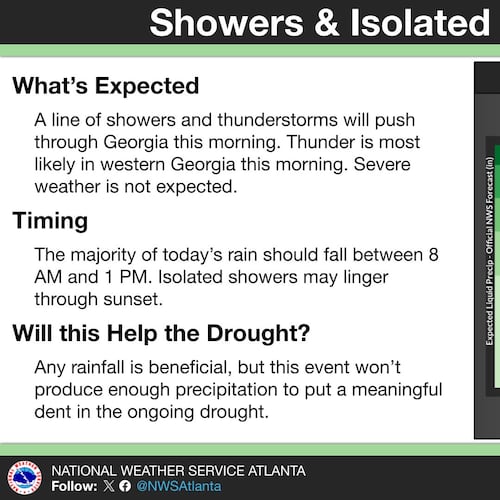As temperatures in metro Atlanta sank below freezing, local governments and nonprofits rushed to open warming shelters with extended hours to keep people safe.
For some who were out in the cold, though, the calculus of what to do isn’t always straightforward.
Leneth Reid stood outside a warming center in downtown Atlanta on Tuesday morning in a freezing wind, weighing his options.
He was supposed to be at an interview for a custodial job at Hartfield-Jackson International Airport. If he could get a ride there, a job could bring him some much-needed income.
But he worried that if he left, he would lose his spot at the city’s warming station in a Central Park recreation center.
”Something is telling me to go for the job,” he said. “It’s a rough decision.”
His eyes widened as Rev. Siegfried Darcell White pulled up in a white van outside the warming center and dropped off a group of more people who quickly filed inside the recreation center.
Reid, 40, said police had brought him to the warming center around 2 a.m., from a MARTA station in College Park. He said he was glad to have a safe place to stay. A job, though? That would have its own crucial rewards.
Normally, when it gets cold enough, local governments open overnight warming stations. But the expected chill is so deep that some said their stations will remain open continuously through at least Thursday morning.
Already, the city of Atlanta saw heavy demand at its primary government-run shelter. Meanwhile, volunteers and others fanned out in an attempt to give people without homes rides to the shelters.
Still, some may not get word of the warming stations or have trouble getting to them, despite the efforts of volunteers and groups. Others worry about leaving behind crucial belongings like tents, tarps or clothing that might get stolen while they are away. Others, some of whom might have mental health issues or active drug addictions, are uncomfortable in crowds or with shelter rules.
Several hundred people will go inside local public and private warming stations because of the cold, said Cathryn Vassell, the chief executive officer of Partners for Home. But several hundred others likely won’t, she said.
“The reality is the challenge we are often up against is there are people who still refuse despite our best efforts,” said Vassell, whose organization works with the city to get people who are homeless into longer-term housing but also helps coordinate getting people out of the cold temporarily.
The deaths of at least 30 people in Fulton County have been tied to hypothermia in the last three years, according to the local medical examiner’s office. Most of them were considered homeless.
Temperatures are expected to fall below freezing at least parts of nearly every day for nearly a week. Adding to the impact of the chill: Recent rain likely dampened tents, sleeping bags, jackets and clothing of people in homeless encampments. Sometimes it can take days for stuff to dry out.
Matthew Curry was at the city’s warming station on Tuesday, seeking shelter as temperatures plummeted.
“Last night I had to sleep outside on the ground,” he said. “Didn’t know it was going to rain. That was a real bad experience for me, but by the grace of God I got through it.”
Credit: arvin.temkar@ajc.com
Credit: arvin.temkar@ajc.com
Atlanta officials say they will have enough space to get people into warm places temporarily.
“We never turn anyone away,” Asher Morris, the city’s deputy director for the Office of Emergency Preparedness, wrote in an email Tuesday. “Depending on the demand, we also have access to additional cots and mats that can be used to build capacity within the center. Should demand necessitate, we will continue working with our shelter partners and Partners for HOME to increase capacity in other locations.”
Demand is actually lower this year compared to cold snaps in the previous years, Morris wrote.
Over the last year, nearly 800 people in Atlanta who had been living outside have been placed into longer term housing, according to Partners for Home. Still, about 2,700 people in the city were considered homeless during the last count nearly a year ago. Volunteers are slated to go out next week to begin the next scheduled annual count.
The number of people considered homeless in the city of Atlanta increased between 2022 to 2023, but overall numbers are down from where they were several years ago, Vassell said.
Atlanta’s warming center at Central Park is expected to remain open at least into Thursday.
Najee Williams, another man taking shelter at the center, said he had been in prison for about a year and a half. After his release on Jan. 10, he said he was staying at a Greyhound bus station for two or three days until he was forced to leave there. He ended up at Hartfield-Jackson and a police officer brought him from there to the Atlanta warming center about 3 a.m. Tuesday. He said he took a hot shower, ate two sandwiches and went to sleep.
”I’d live here if I could,” said Williams, who grew up in Norcross and said he is 18 or 19 years old.
Credit: John Spink/AJC
Credit: John Spink/AJC
DeKalb County made four warming centers 24-hour-a-day operations for the first time since late 2022. They are expected to stay open until Thursday morning. The county also has four only-overnight warming centers for residents. All told, the county can accommodate just over 650 people. A county spokesman said that should be enough space but the government also can turn to churches and other nonprofit organizations as needed.
In Gwinnett, five overnight warming centers were scheduled to be opened, according to a county spokesperson.
Elsewhere, the Salvation Army Red Shield Shelter planned to open overnight to those not already assigned a bed Tuesday as well as Wednesday night. Also, a Salvation Army location in Gwinnett will provide a warm space for people to stay during the day, and a Salvation Army International Corps location in Doraville can provide warming kits.
Locals in other parts of Georgia were also bracing as temperatures plunged.
Officials in Macon expanded capacity at a trio of homeless shelters and warmings centers by a total of 110 beds, from about 210 on an ordinary night to 320.
“Our system wants to ensure that every living human being has a safe place to stay when the weather is vicious,” said the Rev. Jake Hall, executive director of United to End Homelessness.
Hard-freeze warnings extended to northern Florida’s Gulf Coast.
— Joe Kovac Jr., Arvin Temkar, Taylor Croft, Jim Gaines and Jillian Price contributed to this story.
The Latest
Featured




